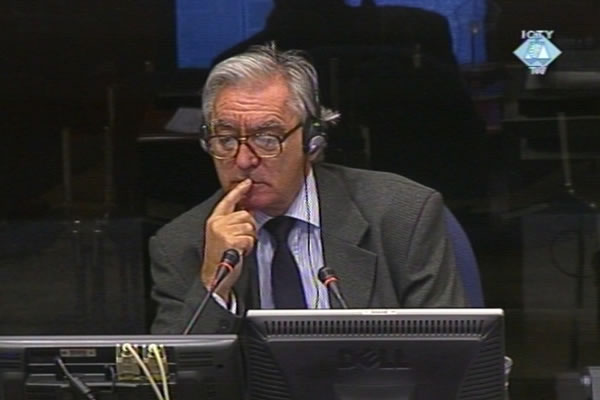Home
ARE BARRACKS A LEGITIMATE MILITARY TARGET?
Ante Gotovina's defense counsel has tried to prove that the shelling of Knin in August 1995 was directed at military, not civilian targets. In his evidence for the prosecution, retired colonel of the Krajina Serb army Kosta Novakovic has maintained that there were no legitimate military targets in the town: there are reasons why even the barracks could not be targeted
 Kosta Novakovic, witness in the Gotovina, Cermak and Markac trial
Kosta Novakovic, witness in the Gotovina, Cermak and Markac trial At the trial of the three Croatian generals, Gotovina’s defense counsel Luka Misetic did not change approach in his cross-examination of Kosta Novakovic, retired colonel of the Krajina Serb army, during his third day on the stand. Arguing that the movement of the Serb population in the first days of Operation Storm in August 1995 was not spontaneous, contrary to what the witness claimed, Misetic noted that the movement of Serbs was planned and implemented by the political and military leadership of the so-called RSK.
The defense counsel first argued that the shelling of Knin did not cause the panic among the population; as he alleged, only military targets in town were attacked, including the two military barracks in Knin which were legitimate military targets. However, Novakovic noted that this would be correct only if combat units were deployed there. At that moment, Novakovic explained, only some Medical Corps and other logistics personnel were present in the barracks.
According to the defense, the TVIK factory in Knin was another military target in Knin; Defense counsel Misetic corroborated this claim by showing a broadcast of the Krajina TV from September 1994 reporting on the talks military leadership held with the factory management regarding the ‘military production program’ and showing an order of the Defense Ministry from July 1995 to switch part of the plant from civilian to military purpose. The witness didn’t contest the fact that such plans existed. However, as he put it, it didn’t mean that they were implemented. When he visited the TVIK factory, the witness contends, he didn’t see any military production going on.
In his cross-examination, Novakovic remained adamant that the Krajina leadership didn’t plan to move the Serb population to BH in the first few days of Operation Storm. According to him, on 4 August 1995 the Krajina leadership adopted an evacuation plan to remove the people from threatened areas in Northern Dalmatian and Lika to safer locations in Krajina. The witness, however, agreed with the defense counsel that the population continued moving towards Banja Luka and later to Serbia despite such a plan. In his re-examination today, Novakovic tried to clarify why that happened, saying that ‘the general destruction influenced’ the people to decide to keep on moving. There was plenty of space and the logistics-wise the area of Bosanski Petrovac and Banja Luka was better equipped to deal with the large number of refugees than Serb and Lapac where the Krajina leadership intended to evacuate the people temporarily.
Kosta Novakovic completed his evidence today. The prosecution will continue its case tomorrow with a new witness.
Linked Reports
- Case : Gotovina et al. - "Operation Storm"
- 2008-11-14 GOTOVINA DEFENSE INVOKES MARTIC AND STRBAC
- 2008-11-13 FINAL DESTINATION FOR THE EVACUEES
- 2008-11-12 INVESTIGATION SIX YEARS AFTER GRUBORI MURDERS
- 2008-11-18 ‘CERMAK DID NOTHING ABOUT CRIME REPORTS’
- 2008-11-21 PROSECUTION MILITARY EXPERT: ‘GOTOVINA KNEW ABOUT CRIMES’
- 2008-11-24 PROSECUTION: GOTOVINA ‘INCITED’ CRIMES BY DOING NOTHING
